Book contents
- Frontmatter
- Studies in Elizabethan and Jacobean Drama since 1900
- Shakespeare and Lyly
- Shakespeare and Mundy
- Marlowe as Provocative Agent in Shakespeare’s Early Plays
- The Tragedy of Revenge in Shakespeare and Webster
- The Simplicity of Thomas Heywood
- The Tragic Vision of Fulke Greville
- Shakespeare v. The Rest: The Old Controversy
- Shakespeare’s Gentleness
- Milton on Shakespeare
- An Unrecorded Elizabethan Performance of Titus Andronicus
- Stratford-upon-Avon a Hundred Years Ago
- International Notes
- Shakespeare Productions in the United Kingdom: 1959
- Three Directors: a Review of Recent Productions
- The Year's Contributions to Shakespearian Study 1 Critical Studies
- 2 Shakespeare’s Life, Times and Stage
- 3 Textual Studies
- Books Received
- Index
- Plate section
The Simplicity of Thomas Heywood
Published online by Cambridge University Press: 28 March 2007
- Frontmatter
- Studies in Elizabethan and Jacobean Drama since 1900
- Shakespeare and Lyly
- Shakespeare and Mundy
- Marlowe as Provocative Agent in Shakespeare’s Early Plays
- The Tragedy of Revenge in Shakespeare and Webster
- The Simplicity of Thomas Heywood
- The Tragic Vision of Fulke Greville
- Shakespeare v. The Rest: The Old Controversy
- Shakespeare’s Gentleness
- Milton on Shakespeare
- An Unrecorded Elizabethan Performance of Titus Andronicus
- Stratford-upon-Avon a Hundred Years Ago
- International Notes
- Shakespeare Productions in the United Kingdom: 1959
- Three Directors: a Review of Recent Productions
- The Year's Contributions to Shakespearian Study 1 Critical Studies
- 2 Shakespeare’s Life, Times and Stage
- 3 Textual Studies
- Books Received
- Index
- Plate section
Summary
The time is past when it was possible to maintain, with Hazlitt, that ‘Heywood’s plots have little of artifice or regularity of design to recommend them’. The complaint, it is true, could still be heard not so long ago: even in A Woman Killed with Kindness, it was said, ‘the subplot continually interferes with and interrupts the important main action’ and the author ‘might better have employed the “two hours traffic” of his stage in filling out the story of the Frankfords’. But the use of double plots is a thing we have learnt to know among other conventions of Elizabethan art. No one today, it may be assumed, would miss their significance.
In Heywood's case in particular, as Miss Townsend has shown,2 it is clear that they meet artistic requirements. The story of the Mountfords, in his best-known play, is hardly less important than that of the Frankfords: main plot and subplot are bound together by common themes into a complex whole which must be considered in its entirety if the play's dramatic purpose is to be grasped at all. To those who have studied it in this new light, A Woman Killed with Kindness has yielded evidence of its thoughtful intricacy of structure and given scope for renewed interpretation.
However, this technique of the dramatist has not always been vindicated in such a way as to do much for his reputation. Miss Townsend, for her part, is mainly concerned with the 'artistry' of his double plots, and only incidentally with their dramatic meaning. Of the seven plays which she considers, three only, in her estimate, can be regarded as combining two plots 'which complement each other, or which taken together, illustrate some central theme'. A second class comprises two other plays 'whose plots are related by a cause-and-effect relationship'. The remaining two—that is, The Captives and The English Traveller—are works 'in which there seems to be no thematic or causal relationship between the two plots'. Thus, in the majority of cases, there would be only the most outward connexion, or even no connexion at all, no relationship of any significance between the two stories which the author puts together.
- Type
- Chapter
- Information
- Shakespeare Survey , pp. 56 - 65Publisher: Cambridge University PressPrint publication year: 1961



